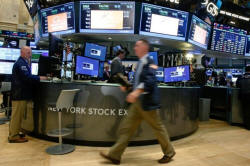|
Peaks, black swans and
bonanzas: Market tips, bold calls and eyecatchers for
2017
 Send a link to a friend
Send a link to a friend
 [November 28, 2016]
By Jamie McGeever [November 28, 2016]
By Jamie McGeever
LONDON
(Reuters) - Politics, economics and finance have all been turned on
their head in 2016, and investors are already looking ahead to 2017 with
anticipation and trepidation.
The consensus, broadly, is that the 35-year bull market in bonds is
over, inflation is back, central banks are maxed out, and for the first
time in a decade any stimulus to the global economy will now come from
governments.
The implications for markets appear to be further increases in bond
yields, developed world stocks and the dollar, while emerging market
currencies, stocks and bonds are expected to struggle under the weight
of higher U.S. bond yields.
In equities, developed markets are favored over emerging, cyclical
sectors over defensive, banks are expected to benefit from steepening
bond yield curves, while infrastructure spending could boost housing and
construction stocks.
That's the consensus. But what goes against that grain? Where might the
wrinkles appear? And even within the broad consensus, are there any
eye-catching forecasts or trade recommendations?
1. Bond yields to FALL?
HSBC, who correctly called the recent slide in U.S. bond yields to
historic lows, says bond yields may well rise next year and expects
10-year Treasury yields to hit 2.5 percent.

But in the first quarter.
After that, HSBC's bond strategist Steven Major reckons they will fall
back sharply again to 1.35 percent - effectively retesting the
multi-decade low struck this year - because an initial rise to 2.5
percent would be unsustainable by tightening financial conditions,
dragging on the economy and constraining the Fed. A bold call.
2. "Peak" 2016
For Bank of America Merrill Lynch, 2016 saw "peak liquidity, peak
inequality, peak globalization, peak deflation" and the end of the
biggest ever bull market in bonds. That all starts to reverse next year.
"For the first time since 2006, there will be no big easing of monetary
policy in the G7, and interest rates and inflation will surprise to the
upside."
They even pin a date on when the bond bull run likely ended: July 11,
2016, when the 30-year U.S. bond yield bottomed out at 2.088 percent.
It's 3 percent today.
3. Black Swans
Economists at Societe Generale illustrate a graphic with four "black
swans" that could blight the global economic and market landscape next
year for good or bad. Mostly bad news. The tail risks they see as most
likely to alter next year's outlook stem from political uncertainty (30
percent risk factor), the steep increases in bond yields (25 percent), a
hard landing in China (25 percent risk factor), and trade wars (15
percent).
Link: http://tmsnrt.rs/2fYLTrP
4. The euro also rises
"The dollar is overvalued versus other G10 currencies." Not something
you hear too often, but it's the view of Swiss wealth management giant
UBS. They predict the euro will end next year at $1.20, going against
the growing calls for parity (it hit a one-year low below $1.06 last
week) or even lower. The euro will also draw support from the ECB
tapering its QE, while undervalued sterling will pick itself up from its
Brexit mauling to rally against the greenback.
5. The "good carry" in EM
Few dispute that a higher dollar and U.S. yields next year will hurt
emerging markets. Goldman Sachs has long championed a stronger dollar
and higher yields. Two of their top 2017 trade tips, however, involve
buying EM assets.

[to top of second column] |

Traders work on the floor of the New York Stock Exchange (NYSE) in
New York City, U.S., November 10, 2016. REUTERS/Brendan McDermid

One is going long on an equally weighted FX basket of Brazilian real,
Russian rouble, Indonesian rupiah and South African rand versus short on
an equally weighted basket of Korean won and Singapore dollar to earn
"the good carry". The other is going long Brazilian, Indian and Polish
equities.
6. More QE from the ECB?
Inflation has bottomed out, the Fed is raising rates, and other central
banks are beginning to reduce their stimulus. The ECB will taper its 80
billion euros-a-month QE program, right?
Maybe not.
RBC Capital Markets expects the ECB to not only extend QE in December,
but to consider extending it again later next year as inflation and
growth fall short. "Even toward the end of 2017, the discussion will be
very similar to that seen at present: how can the ECB continue to
stimulate the economy?"
That could widen the already yawning gap between U.S. and euro zone
yields. The 10-year spread this week hit its widest in over quarter of a
century (210 basis points) and a fall in the 2-year German yield to a
record low -0.74 pct pushed the spread to its widest in a decade (185
bps).
7. $1 trillion U.S. earnings bonanza
How much offshore earnings can U.S. companies bring back if
president-elect Trump follows through with his pledge to cut corporate
tax? About $1 trillion, according to estimates by Deutsche Bank. This
could give U.S. stocks, already at record highs, another shot in the
arm. Citi reckons global equities will rise 10 percent next year, led by
developed market indices. A 10 percent rise in the dollar and cut in
U.S. corporation tax to 20 percent could add 6 percent to global
earnings per share. "If other countries also cut taxes then EPS could
rise further, even against an uninspiring economic backdrop."
8. China shop bull returns
Chinese stocks will bounce back into a roaring bull market, predicts
Morgan Stanley. It reckons the Shanghai Composite index will end next
year at 4,400 points versus 3,241 currently - a 36 percent increase. It
also sees EPS growth at 6 pct, up from a previous forecast of 4 pct.
This is predicated on there being no "significant" U.S.-China trade
protectionism conflict, although the threat of such a conflict and the
relatively early stage of the Chinese recovery will keep domestic
monetary conditions loose in the first half of 2017. Tougher property
sector rules are also starting to divert wealthy individuals' capital
toward stocks, MS says. "Overall, we expect a more extended and subdued
bull market than last time." If they're right, 36 percent isn't too
shabby in anyone's books.
(Reporting by Jamie McGeever; Additional reporting by Atul Prakash and
Vikram Subhedar; Editing by Hugh Lawson and Toby Chopra)
[© 2016 Thomson Reuters. All rights
reserved.] Copyright 2016 Reuters. All rights reserved. This material may not be published,
broadcast, rewritten or redistributed.
 |